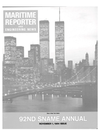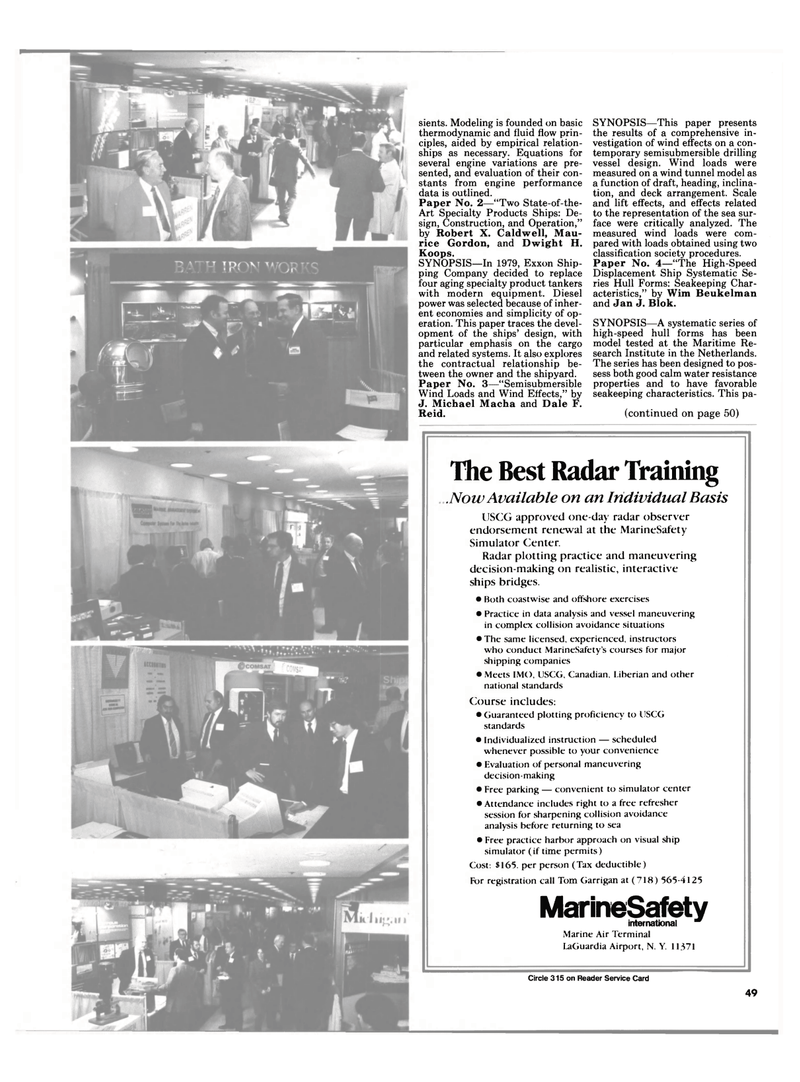
Page 45: of Maritime Reporter Magazine (November 1984)
Read this page in Pdf, Flash or Html5 edition of November 1984 Maritime Reporter Magazine
sients. Modeling is founded on basic thermodynamic and fluid flow prin- ciples, aided by empirical relation- ships as necessary. Equations for several engine variations are pre- sented, and evaluation of their con- stants from engine performance data is outlined.
Paper No. 2—"Two State-of-the-
Art Specialty Products Ships: De- sign, Construction, and Operation," by Robert X. Caldwell, Mau- rice Gordon, and Dwight H.
Koops.
SYNOPSIS—In 1979, Exxon Ship- ping Company decided to replace four aging specialty product tankers with modern equipment. Diesel power was selected because of inher- ent economies and simplicity of op- eration. This paper traces the devel- opment of the ships' design, with particular emphasis on the cargo and related systems. It also explores the contractual relationship be- tween the owner and the shipyard.
Paper No. 3—"Semisubmersible
Wind Loads and Wind Effects," by
J. Michael Macha and Dale F.
Reid.
SYNOPSIS—This paper presents the results of a comprehensive in- vestigation of wind effects on a con- temporary semisubmersible drilling vessel design. Wind loads were measured on a wind tunnel model as a function of draft, heading, inclina- tion, and deck arrangement. Scale and lift effects, and effects related to the representation of the sea sur- face were critically analyzed. The measured wind loads were com- pared with loads obtained using two classification society procedures.
Paper No. 4—"The High-Speed
Displacement Ship Systematic Se- ries Hull Forms: Seakeeping Char- acteristics," by Wim Beukelman and Jan J. Blok.
SYNOPSIS—A systematic series of high-speed hull forms has been model tested at the Maritime Re- search Institute in the Netherlands.
The series has been designed to pos- sess both good calm water resistance properties and to have favorable seakeeping characteristics. This pa- (continued on page 50)
The Best Radar Training .Now Available on an Individual Basis
USCG approved one-day radar observer endorsement renewal at the MarineSafety
Simulator Center.
Radar plotting practice and maneuvering decision-making on realistic, interactive ships bridges. • Both coastwise and offshore exercises • Practice in data analysis and vessel maneuvering in complex collision avoidance situations • The same licensed, experienced, instructors who conduct MarineSafety's courses for major shipping companies • Meets IMC), USCG, Canadian. I.iberian and other national standards
Course includes: • Guaranteed plotting proficiency to USCG standards • Individualized instruction — scheduled whenever possible to your convenience • Evaluation of personal maneuvering decision-making • Free parking — convenient to simulator center • Attendance includes right to a free refresher session for sharpening collision avoidance analysis before returning to sea • Free practice harbor approach on visual ship simulator (if time permits)
Cost: $165. per person (Tax deductible)
For registration call Tom Garrigan at (718) 565-4125
MarineSafety international
Marine Air Terminal
LaGuardia Airport, N. Y. 11371
Circle 315 on Reader Service Card 49

 44
44

 46
46
